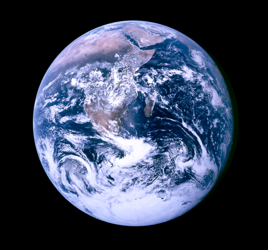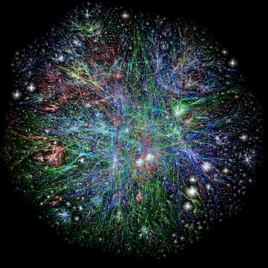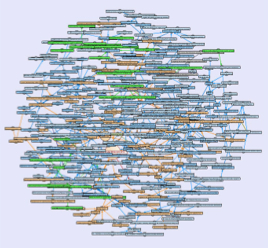Daologue
From space we see the Earth as a whole, enveloped in a thin and astonishingly beautiful layer of life; weather systems merging, ocean currents swirling, storm clouds erupting lightning, and night flowing into day across an imperceptibly fluid tectonic landscape.
What if we could see our entire planetary conversation flowing in a similar way? What might it look like? Its patterns and themes. Its streams and structures. Its forks and merges. Its bifurcating branches. Its dead ends. Its beautiful possibilities. And how might we listen and act differently given this perception of the conversation of the Earth, this enveloping planetary layer, this connecting and collecting intelligence, this sum of all dialogues: this Daologue?*
Contemplating a lifetime’s conversations, I’m struck by the degree to which our communication feels elevated – healthier – when some sense of Daologue is present: and feels diminished in its absence. Awareness of this additional dimensionality seems to encourage a Copernican shift, a softening iterative provisionality, curiosity, openness, empathy, and an attentiveness to what is not being heard; each of which strengthens our immunity to the pathology that ensues when someone or something speaking saliently to a given situation is not heard.
And yet so much of our public discourse, our party politics, our narcissistic filter bubbles, our sensationalizing media, our vituperative comment streams, feels so far adrift from this quality and possibility – a pathology growing within ourselves as well as between ourselves – and so anachronous and ill-matched to the challenging complexity of the patterns we are creating in the world.
Imbuing our public and private conversations with a greater sense of Daologue might be one of the imperatives of our age. Challenging us to become more literate in understanding and adept at working with this meta-perspective; challenging us to cultivate this awareness and quality within and between ourselves and to cultivate the spaces in which it thrives, and to develop our skills at tending to Daologue. In doing so, I wonder, too, if we might start to conceive of Daologue in its entirety as one of our most precious and uncharted resources; a commonwealth of meaning from which an ever-renewing stream of insight and innovation can be discovered, harvested and shared.
Opte Project: The Internet – 2003
The emergence of the web and our global infrastructure and real-time, social media heighten our awareness and experience of participating in a planetary conversation, and offer startling and tantalizing visual proxies for the structure and flow of Daologue. They also offer new ways to explore, develop our literacy in and empathy towards, and to work creatively with Daologue at unfamiliar scales – and to detect and parse continuously evolving signals from the continuously evolving noise.
I will expand on this theme in due course. For now though, a first step is simply to notice in wonder that our words and our inner and outer dialogues are always part of this Daologue; permutations of a kaleidoscopic pattern that is continuously forming and reforming, informing and being informed, as an astonishingly beautiful and meaningful whole.
To be, or not to be, that is the debate map
A light-hearted debate map of Hamlet’s existential dilemma in Act III Scene I, to commemorate the 444th anniversary of William Shakespeare’s birth on 23 April 1564.

Without further ado, here’s the soliloquy—the medium in which sensitive young men worked out their feelings pre-YouTube:
“To be, or not to be, that is the question;
Whether ’tis nobler in the mind to suffer
The Slings and Arrows of outrageous Fortune
Or to take arms against a sea of troubles,
And by opposing, end them. To die, to sleep;
No more; and by a sleep to say we end
The heart-ache and the thousand natural shocks
That flesh is heir to — ’tis a consummation
Devoutly to be wish’d. To die, to sleep;
To sleep, perchance to dream. Ay, there’s the rub,
For in that sleep of death what dreams may come,
When we have shuffled off this mortal coil,
Must give us pause. There’s the respect
That makes calamity of so long life,
For who would bear the whips and scorns of time,
Th’oppressor’s wrong, the proud man’s contumely,
The pangs of dispriz’d love, the law’s delay,
The insolence of office, and the spurns
That patient merit of th’unworthy takes,
When he himself might his quietus make
With a bare bodkin? who would fardels bear,
To grunt and sweat under a weary life,
But that the dread of something after death,
The undiscovered country from whose bourn
No traveller returns, puzzles the will,
And makes us rather bear those ills we have
Than fly to others that we know not of?”
…and here’s the map of Hamlet’s internal struggle (complete with the embed code for his MySpace blog):
So, how do you rate Hamlet’s arguments—does the proud man’s contumely really sting more than the pangs of dispriz’d love? Either way, I guess Valleywag has the story covered—and, at the risk of a skewed sample, what do you make of Hamlet’s conclusion?
“Thus conscience does make cowards of us all,
And thus the native hue of resolution
Is sicklied o’er with the pale cast of thought,
And enterprises of great pitch and moment
With this regard their currents turn away,
And lose the name of action.”




